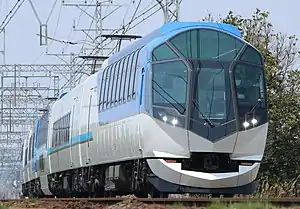| Kintetsu 5200 series | |
|---|---|
 5200 series set 5207 bound for Matsusaka | |
| In service | 1988–present |
| Manufacturer | Kinki Sharyo |
| Constructed | 1988–1993 |
| Entered service | 1988 |
| Refurbished | 2007–2014 |
| Number built | 52 vehicles (13 sets) |
| Number in service | 52 vehicles (13 sets) |
| Formation | 4 cars per trainset |
| Fleet numbers | 5201–5213 |
| Capacity | 132 (intermediate cars) 124 people (end cars) |
| Operators | Kintetsu Railway |
| Lines served | |
| Specifications | |
| Car body construction | Steel |
| Car length | 20,720 mm (68 ft 0 in)[1] |
| Width | 2,800 mm (9 ft 2 in)[1] |
| Height | 4,150 mm (13 ft 7 in)[1] |
| Doors | 3 pairs per side |
| Maximum speed | 110 km/h (68 mph) |
| Traction system | Variable frequency (GTO)[2] |
| Traction motors | MB-5023/5035-A/B |
| Power output | 165 kW (221 hp) per motor |
| Electric system(s) | 1,500 V DC, overhead lines |
| Current collector(s) | Pantograph |
| Track gauge | 1,435 mm (4 ft 8+1⁄2 in) |
The Kintetsu 5200 series (近鉄5200系) is an electric multiple unit (EMU) train type operated by Kintetsu Railway in Japan on limited express services on the Osaka and Nagoya Lines.[2]
Variants
Overview
Formations
5200 series sets are formed as follows.
| Car | 1 | 2 | 3 | 4 |
|---|---|---|---|---|
| Designation | Ku 5100 | Mo 5200 | Mo 5250 | Ku 5150 |
| Capacity (total) | 124 | 132 | 124 | |
The two 5209 series sets (5209–5210) are formed as follows.
| Car | 1 | 2 | 3 | 4 |
|---|---|---|---|---|
| Designation | Ku 5109 | Mo 5209 | Mo 5259 | Ku 5159 |
The three 5211 series sets (5211–5213) are formed as follows.
| Car | 1 | 2 | 3 | 4 |
|---|---|---|---|---|
| Designation | Ku 5111 | Mo 5211 | Mo 5261 | Ku 5161 |
Interior
Seating consists of perpendicular seating throughout.
 Interior after refurbishment work
Interior after refurbishment work_Interior2.JPG.webp) Wheelchair space added after refurbishment
Wheelchair space added after refurbishment Upgraded onboard washroom facilities
Upgraded onboard washroom facilities
History
The trains were introduced in 1988 to fulfill a need for long-distance services as well as for replacing aging 2600 series trainsets.
The design of the trains revolved around three principles:[4]
- More comfortable
- Multi purpose (Vehicles suitable for morning and evening commuting, daytime long-distance express transportation, and for private charters)
- Modern technology (For ease of maintenance)
In 1988, the series won the Good Design Award by the Japan Institute of Design Promotion.[3]
In September 2014, set 5205 was repainted in a commemorative livery from the 1960s.[5]
 Set 5205 in a commemorative livery
Set 5205 in a commemorative livery
References
- 1 2 3 三好好三 (2016). 近鉄電車 [Kintetsu train] (in Japanese). JTB Publishing. p. 125. ISBN 9784533115318.
- 1 2 近畿日本鉄道のひみつ [The secret of Kintetsu Railway] (in Japanese). Tōkyō: PHP Kenkyūjo. 2013. pp. 118–119. ISBN 978-4-569-81142-0. OCLC 848597940.
{{cite book}}: CS1 maint: date and year (link) - 1 2 3 4 河久, 諸; 山邊誠 (1998). 日本の私鉄近鉄 II [Japanese Private Railway Kintetsu II] (in Japanese). Hoikusha. p. 62. ISBN 9784586509058.
- ↑ "鉄道ファン" [Railway Fan]. 鉄道ファン (in Japanese). 326: 81–85. June 1988.
- ↑ "近鉄エリアキャンペーン記念列車」が出場" ["Kintetsu area campaign commemorative train" participates]. Japan Railfan Magazine Online (in Japanese). Japan: Koyusha Co., Ltd. 11 September 2014. Retrieved 27 January 2022.
External links
- Kintetsu official website (in Japanese)
